1993 PONTIAC GRAND-AM ABS
[x] Cancel search: ABSPage 4 of 306

How to Use this Manual
Using Your 1993 Pontiac
Owner’s Manual
Many people read their owner’s manual
from beginning to end when they first
receive their new vehicle. This will help
you learn about the features and controls
for your vehicle. In this manual, you’ll
find that pictures and words work
together to explain things quickly.
There are nine parts with color-tabbed
pages
in this manual. Each part begins
with a brief list of contents,
so you can
usually tell at a glance if that part
contains the information you want.
You can bend the manual slightly to
reveal the color tabs that help you find a
part.
Part 1: Seats & Safety Belts
This part tells you how to use your seats
and safety belts properly.
Part 2: Features & Controls
This part explains how to start and
operate your Pontiac.
Part 3: Comfort Controls & Audio
Systems
This part tells you how to adjust the
ventilation and comfort controls and
how to operate your audio system.
Part 4: Your Driving and the Road
Here you’ll find helpful information and
tips about the road and how to drive
under different conditions.
Part 5: Problems on the Road
This part tells you what to do if you
have a problem while driving, such as
a
flat tire or engine overheating. ’
Part 6: Service & Appearance Care
Here the manual tells you how to keep
your Pontiac running properly and
looking good.
Part 7: Maintenance Schedule
This part tells you when to perform
vehicle maintenance and what fluids and
lubricants
to use.
Part 8: Customer Assistance
Information
This part tells you how to contact
Pontiac for assistance and how to get
service publications. It also gives you
information on
Reporting Safety Defects.
Part 9: Index
Here’s an alphabetical listing of almost
every subject in this manual. You can
use
it to quickly find something you
want to read.
Service Station Information
This is a quick reference of service
information. You can find it
on the last
page
of this manual.
3
ProCarManuals.com
Page 132 of 306
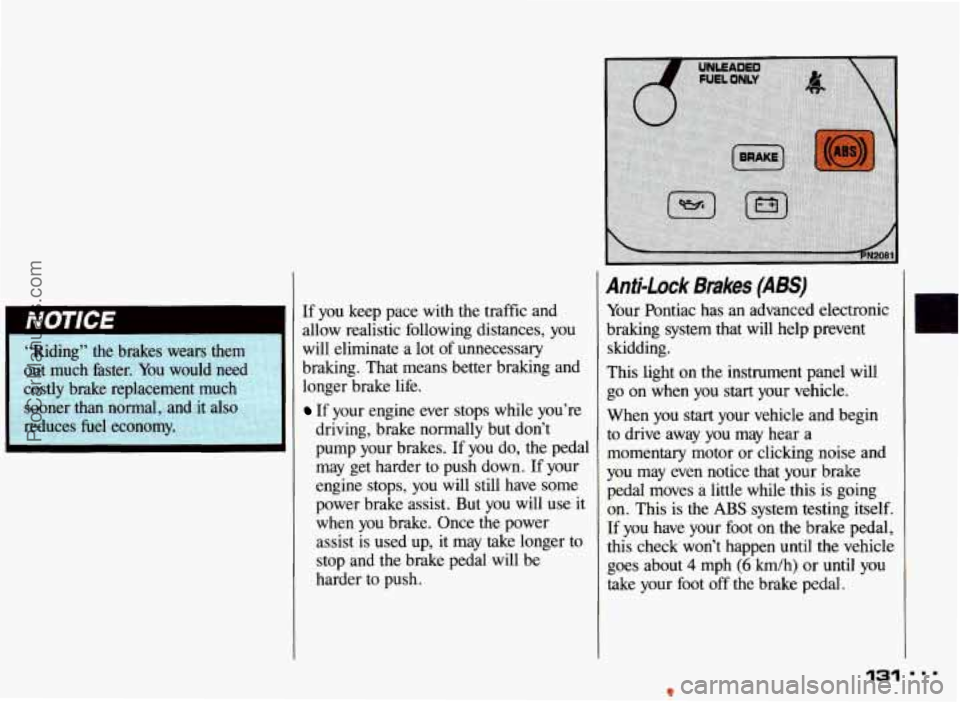
“Riding” the brakes wears them
out much faster. You would need
costly brake replacement
much
sooner than normal, and it also reduces fuel economy. If you keep pace with the traffic and
allow realistic following distances,
you
will eliminate a lot of unnecessary
braking. That means better braking and
longer brake life. If your engine ever stops while you’re
driving, brake normally but don’t
pump your brakes. If you do, the pedal
may get harder to push down. If your
engine stops, you will still have some
power brake assist. But
you will use it
when you brake. Once the power
assist is used up, it may take longer
to
stop and the brake pedal will be
harder to push.
Anti-Lock Bmkes (ABS)
Your Pontiac has an advanced electronic
braking system that will help prevent
skidding.
This light on the instrument panel will
go on when you start your vehicle.
When you
start your vehicle and begin
to drive away you may hear a
momentary motor or clicking noise
and
you may even notice that your brake
pedal moves a little while this is going
on. This is the ABS system testing itself.
If you have your foot on the brake
pedal,
this check won’t happen until the vehicle
goes about
4 mph (6 km/h) or until you
take your foot off the brake pedal.
131
ProCarManuals.com
Page 133 of 306
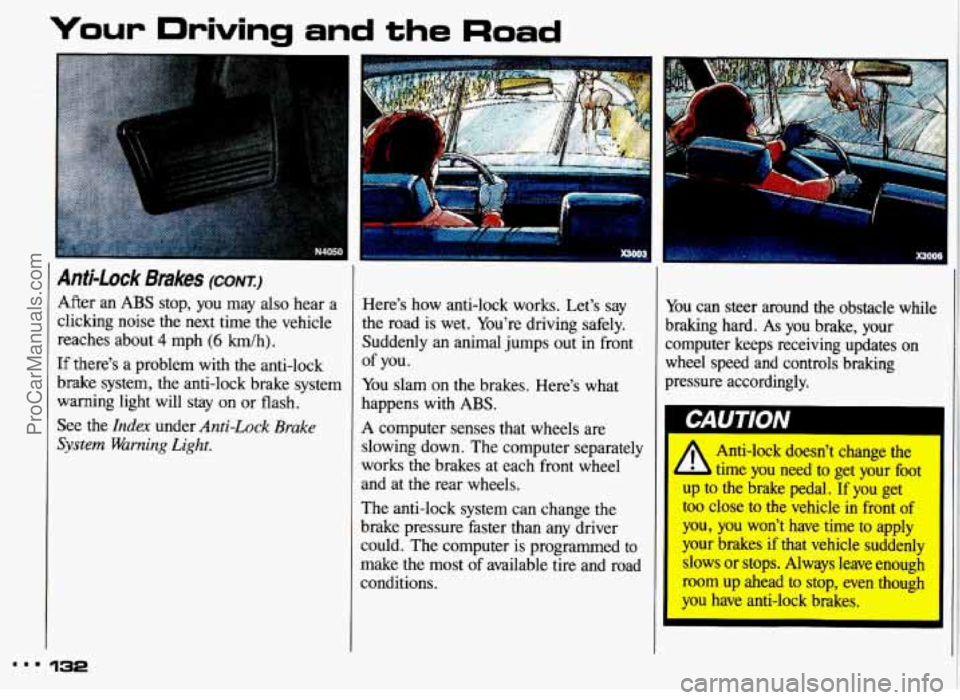
...
Your Driving and the Road
Anti-Lock Brakes (CONT.)
After an ABS stop, you may also hear a
clicking noise the next time the vehicle
reaches about
4 mph (6 km/h).
If there’s a problem with the anti-lock
brake system, the anti-lock brake system
warning light will stay
on or flash.
See the
Index under Anti-Lock Brake
System Warning Light.
132
Here’s how anti-lock works. Let’s say
the road is wet. You’re driving safely.
Suddenly an animal jumps out in front
You slam on the brakes. Here’s what
happens with ABS.
A computer senses that wheels are
slowing down. The computer separately
works the brakes at each front wheel
and at the rear wheels.
The anti-lock system can change the
of you.
brake pressure faster than any driver
could. The computer
is programmed to
make the most
of available tire and road
conditions. You
can steer around the obstacle while
braking hard.
As you brake, your
computer keeps receiving updates on
wheel speed and controls braking
pressure accordingly.
Anti-lock doesn’t change the
time you need
to get your foot
the brake pedal. If you get
too close to the vehicle in front
of
I you, you won’t have time to apply
your brakes
if that vehicle suddenly
slows or stops. Always leave enough
room up ahead to stop, even though
you have anti-lock brakes.
ProCarManuals.com
Page 142 of 306
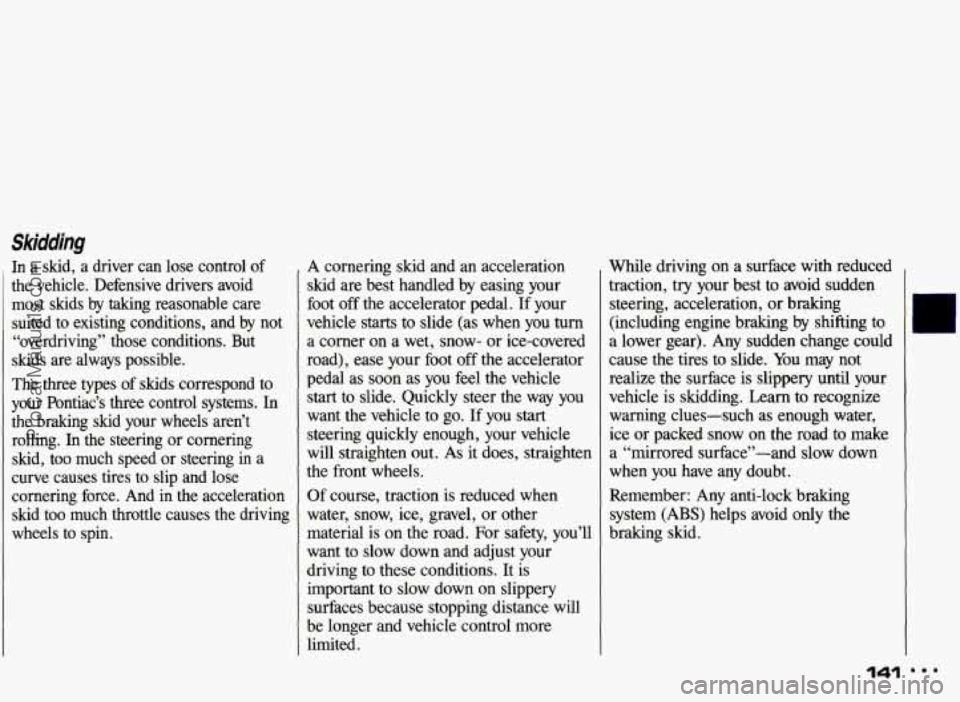
Skidding
In a skid, a driver can lose control of
the vehicle. Defensive drivers avoid
most skids by taking reasonable care
suited to existing conditions, and by not
“overdriving” those conditions. But
skids are always possible.
The three types of skids correspond to
your Pontiac’s three control systems.
In
the braking skid your wheels aren’t
rolling.
In the steering or cornering
skid, too much speed or steering in a
curve causes tires to slip and lose cornering force. And in the acceleration
skid too much throttle causes the driving
wheels to spin. A
cornering skid and an acceleration
skid are best handled by easing your
foot
off the accelerator pedal. If your
vehicle starts to slide (as when you turn
a corner on a wet, snow- or ice-covered
road), ease your foot off the accelerator
pedal as soon as you feel the vehicle
start to slide. Quickly steer the way you
want the vehicle to go.
If you start
steering quickly enough, your vehicle
will straighten out. As it does, straighten
the front wheels.
Of course, traction is reduced when
water, snow, ice, gravel, or other
material is on the road. For safety, you’ll
want to slow down and adjust your
driving to these conditions. It is
important to slow down on slippery surfaces because stopping distance will
be longer and vehicle control more
limited. While driving on
a surface with reduced
traction, try your best to avoid sudden
steering, acceleration, or braking
(including engine braking by shifting to
a lower gear). Any sudden change could
cause the tires to slide.
You may not
realize the surface is slippery until your
vehicle is skidding. Learn to recognize
warning clues-such as enough water,
ice or packed snow
on the road to make
a “mirrored surface”-and slow down
when you have any doubt.
Remember: Any anti-lock braking
system
(ABS) helps avoid only the
braking skid.
141
ProCarManuals.com
Page 158 of 306

Whatever the condition-smooth ice,
packed, blowing or loose snow-drive with caution. Accelerate gently. Try not
to break the fragile traction. If you
accelerate too fast, the drive wheels will spin and polish the surface under the
tires even more.
Your anti-lock brakes improve your
ability
to make a hard stop on a slippery
road. Even though you have the anti-
lock braking system, you’ll want to
begin stopping sooner than you would on dry pavement. See the
Idex under
1 Anti-Lock Brake System (ABS).
Allow greater following distance on
any slippery road.
Watch for slippery spots. The road
might be fine until you hit a spot that’s
covered with ice. On an otherwise
clear road, ice patches may appear in
shaded areas where the
sun can’t
reach: around clumps of trees, behind
buildings, or under bridges.
Sometimes the surface of a curve or
an overpass may remain icy when the
surrounding roads are clear. If you see
a patch
of ice ahead of you, brake
before you are on it.
Try not to brake
while you’re actually on the ice, and
avoid sudden steering maneuvers.
If You’re Caught in a Blizzard
If you are stopped by heavy snow, you
could be in a serious situation.
You
should probably stay with your vehicle
unless you know for sure that you are
near help and you can hike through the
snow. Here are some
things to do to
summon help and keep yourself and
your passengers safe:
Turn on your hazard flashers.
Tie a red cloth to your vehicle to alert
police that you’ve been stopped by the
snow.
157
ProCarManuals.com
Page 166 of 306
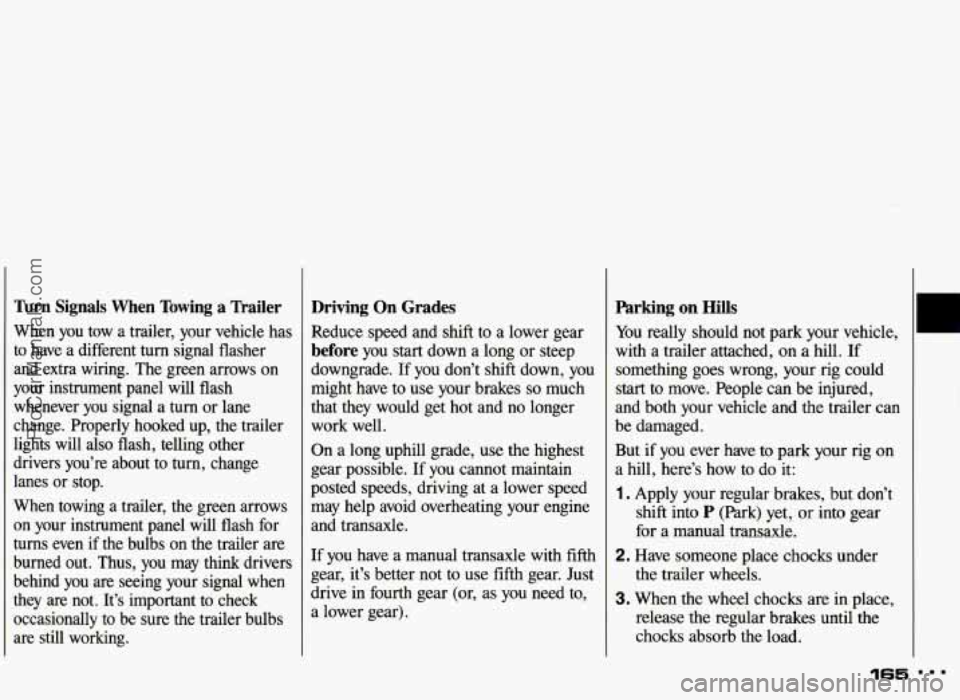
Turn Signals When Towing a ’Railer
When you tow a trailer, your vehicle has
to have a different turn signal flasher
and extra wiring. The green arrows on
your instrument panel will flash
whenever you signal a
turn or lane
change. Properly hooked up, the trailer
lights will also flash, telling other drivers you’re about to turn, change
lanes or stop.
When towing a trailer, the green arrows
on your instrument panel will flash for
turns even if the bulbs on the trailer are
burned out. Thus, you may think drivers
behind you are seeing your signal when
they are not. It’s important to check occasionally to be sure the trailer bulbs
are still working.
Driving On Grades
Reduce speed and shift to a lower gear
before you start down a long or steep
downgrade. If you don’t shift down, you
might have to use your brakes
so much
that they would get hot and no longer work well.
On a long uphill grade, use the highest
gear possible. If you cannot maintain
posted speeds, driving at a lower speed
may help avoid overheating your engine
and transaxle.
If you have a manual transaxle with
fifth
gear, it’s better not to use fifth gear. Just
drive in fourth gear (or, as you need to,
a lower gear).
Parking on Hills
You really should not park your vehicle,
with a trailer attached,
on a hill. If
something goes wrong, your rig could
start to move. People can be injured,
and both your vehicle and the trailer can
be damaged.
But if you ever have to park your rig on
a hill, here’s how to do it:
1. Apply your regular brakes, but don’t
shift into
P (Park) yet, or into gear
for a manual transaxle.
2. Have someone place chocks under
the trailer wheels.
3. When the wheel chocks are in place,
release the regular brakes until the chocks absorb the load.
165 DDD
ProCarManuals.com
Page 250 of 306

Fuse Rating Circuitry
Fuse Usage
HORN
ALARM
HTR-A/C
RDO IGN
TURN
DR LK
TAIL LPS
WDO
WIPER ERLS
FTP
ACC
IGN ECM
HDLP
15
15
25
10
20
20
20
30
25
15
20
30
20
20
Back Up Lights, Electronic PRNDL (automatic transaxle)
Fuel Pump, Fuel Injectors
Turn/Hazard/Stop Lights, Anti-Lock Brakes
(ABS), Brake-
Transaxle Shift Interlock
(BTSI)
Power Door Locks, Power Mirrors, Cigar Lighter
BLANK
Instrument Panel Lights
Rear Window Defogger Relay, Chime, Gages,
ABS , BTSI,
Daytime
Running Lights (Dm) (Canada)
Horn
Chime, Interior Lights, Passive Restraints, Radio/Clock Memory
Heater, Air Conditioning, ABS, DRL (Canada), Engine Block
Heater
Radio, Cruise Control, Variable
Effort Steering
Turn Signals
Power Door Locks
Exterior Lights, Fog Lights, Instrument Panel Lights, DRL
(Canada)
Power Windows (Circuit Breaker)
Windshield WipedWasher
Engine Controls, Starter and Charging System
BLANK
Flash-to-Pass
(US.)
Power Seats, Rear Window Defogger (Circuit Breaker)
BLANK
Engine Control Module, Ignition System
BLANK
Headlights, DRL (Canada) (Circuit Breaker)
ProCarManuals.com
Page 256 of 306
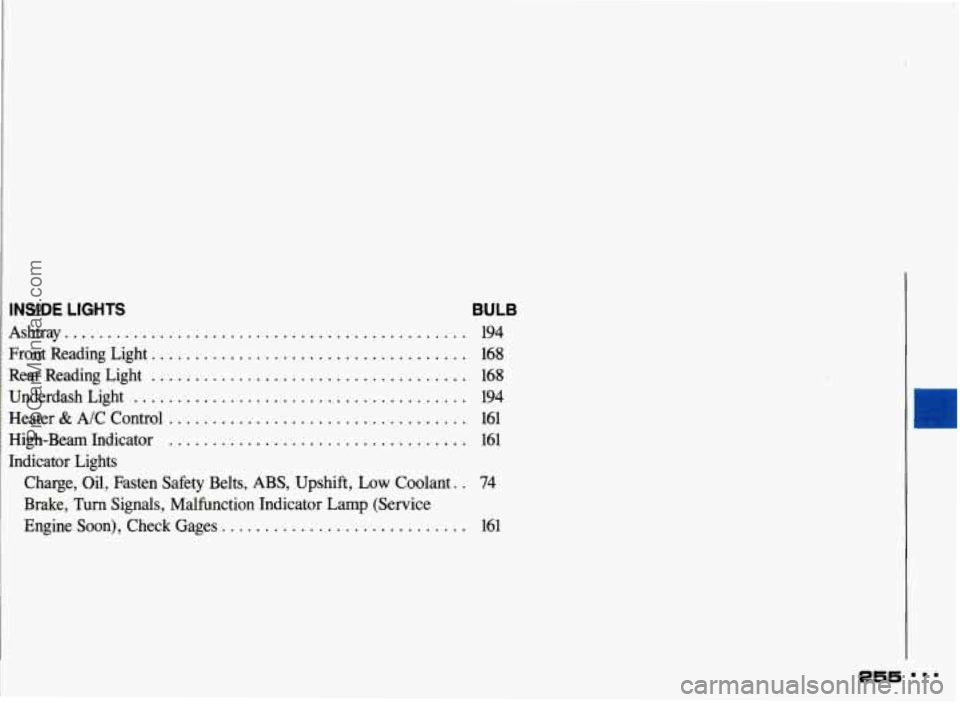
INSIDE LIGHTS BULB
Ashtray .............................................. 194
Front Reading Light.
................................... 168
Rear Reading Light .................................... 168
Underdash Light ...................................... 194
Heater
& A/C Control .................................. 161
High-Beam Indicator
.................................. 161
Indicator Lights Charge, Oil, Fasten Safety Belts,
ABS, Upshift, Low Coolant. . 74
Brake,
Turn Signals, Malfunction Indicator Lamp (Service
Engine Soon), Check Gages
............................ 161
E
255
ProCarManuals.com